Abstract
The potencies of two tachykinin antagonists [D-Pro4,D-Trp7,9,10]-SP(4-11) and [D-Arg1,D-Pro2, D-Trp7,9,Leu11]-SP(1-11) against four tachykinins were examined in a range of smooth muscle preparations, including guinea-pig ileum and bladder and rat colon muscularis mucosae and duodenum. Parallel shifts in the log dose-response curves of all the tachykinins tested were observed in all tissues, except in the case of the guinea-pig bladder where [D-Pro4, D-Trp7,9,10]-SP(4-11) was without effect at concentrations up to 32 microM. The slopes of the Schild plots for the two antagonists did not differ significantly from unity, with the exception of [D-Pro4, D-Trp7,9,10]-SP(4-11) in the rat duodenum, which may indicate a heterogeneous receptor population in this tissue. The antagonists displayed agonist selectivity in the case of the guinea-pig ileum where log dose-response curves to substance P and physalaemin were shifted less than those to eledoisin and kassinin. Rank orders of potency for eledoisin, kassinin, physalaemin and substance P in the five preparations studied allowed classification of the tissues by the predominant receptor type according to the 'SP-P' and 'SP-E' scheme. It is concluded that [D-Pro4, D-Trp7,9,10]-SP(4-11), in particular, displays tissue selectivity that may indicate different receptor populations, but classification of receptor and tissue types on this basis does not fully correspond with classifications based on agonist potencies. Such schemes should therefore be treated with caution at this stage.
Full text
PDF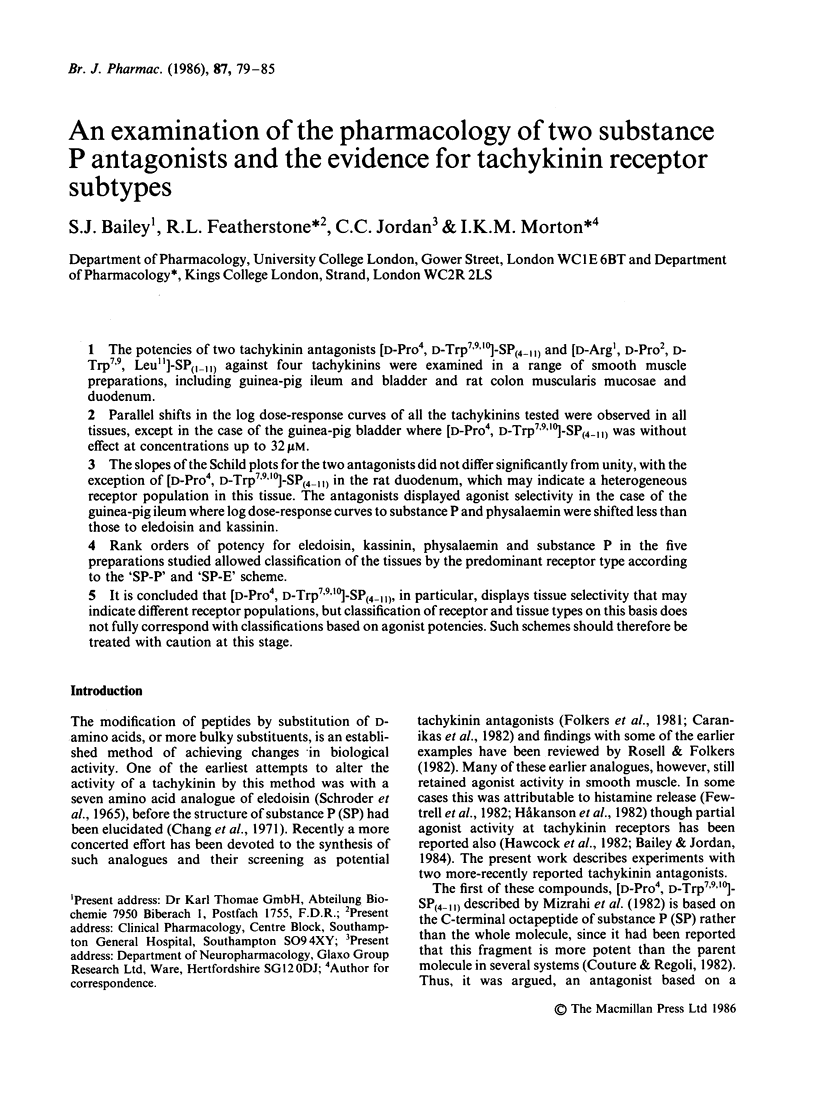

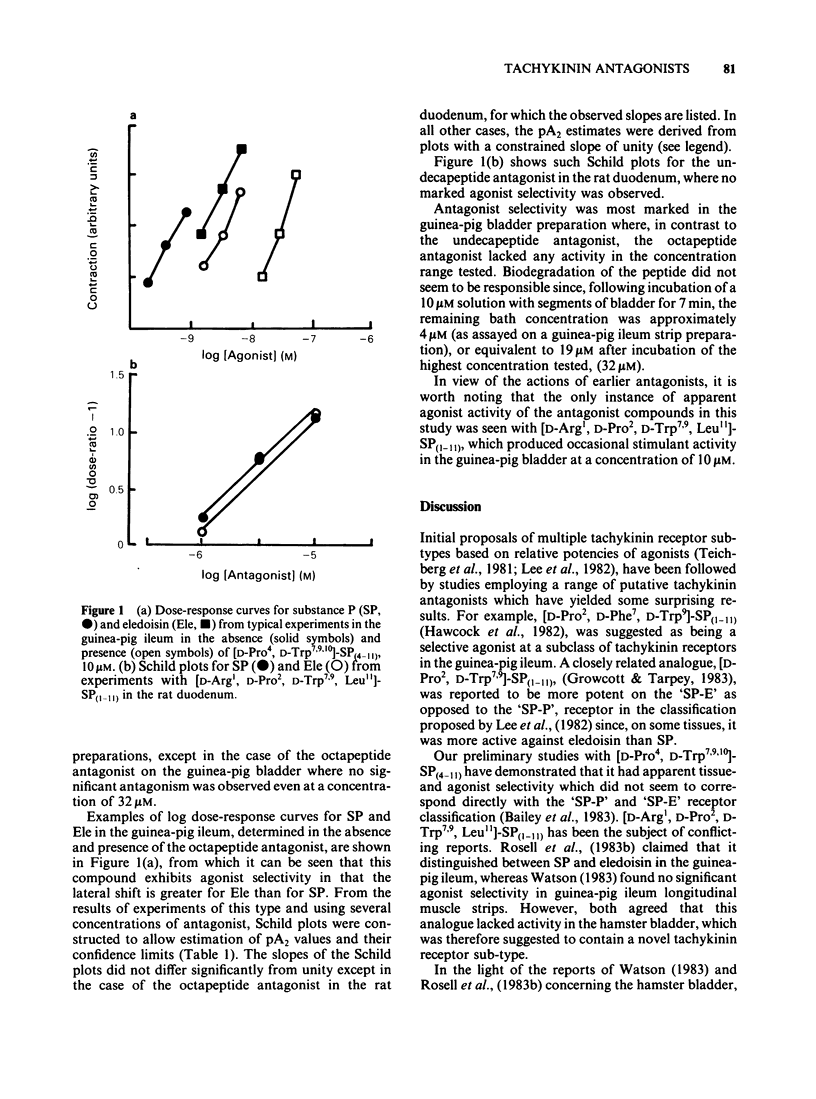

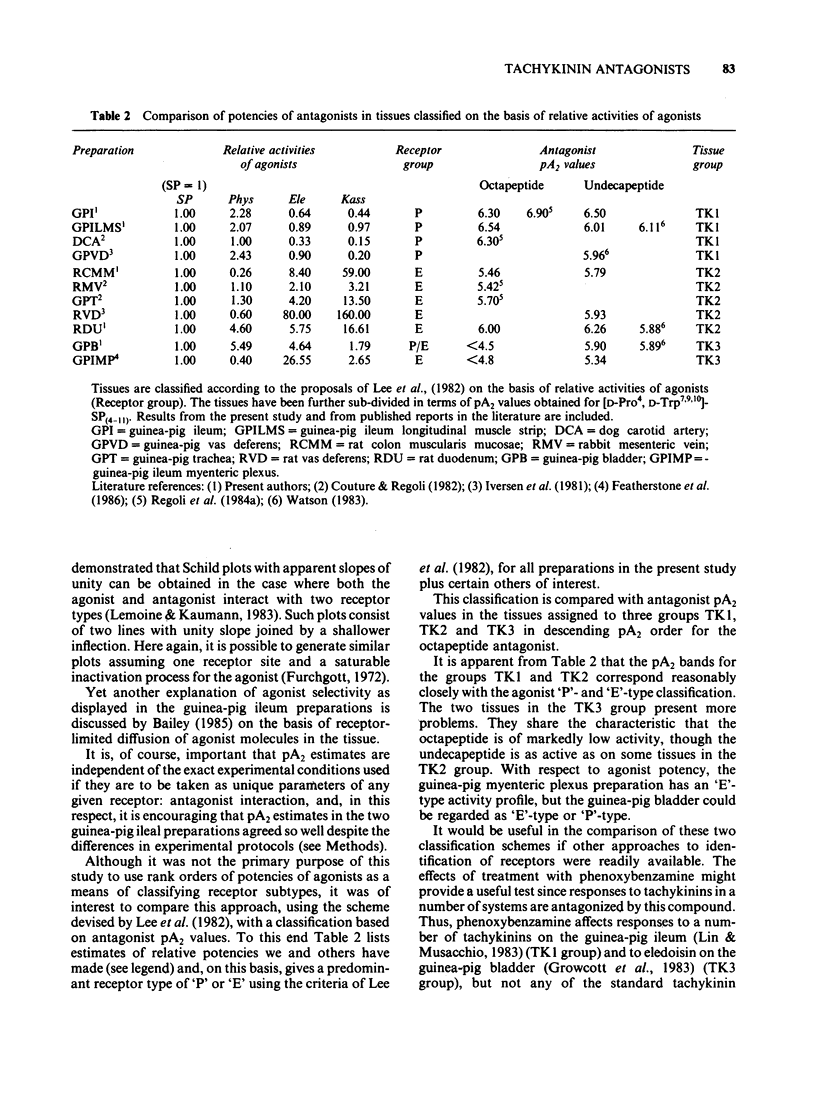
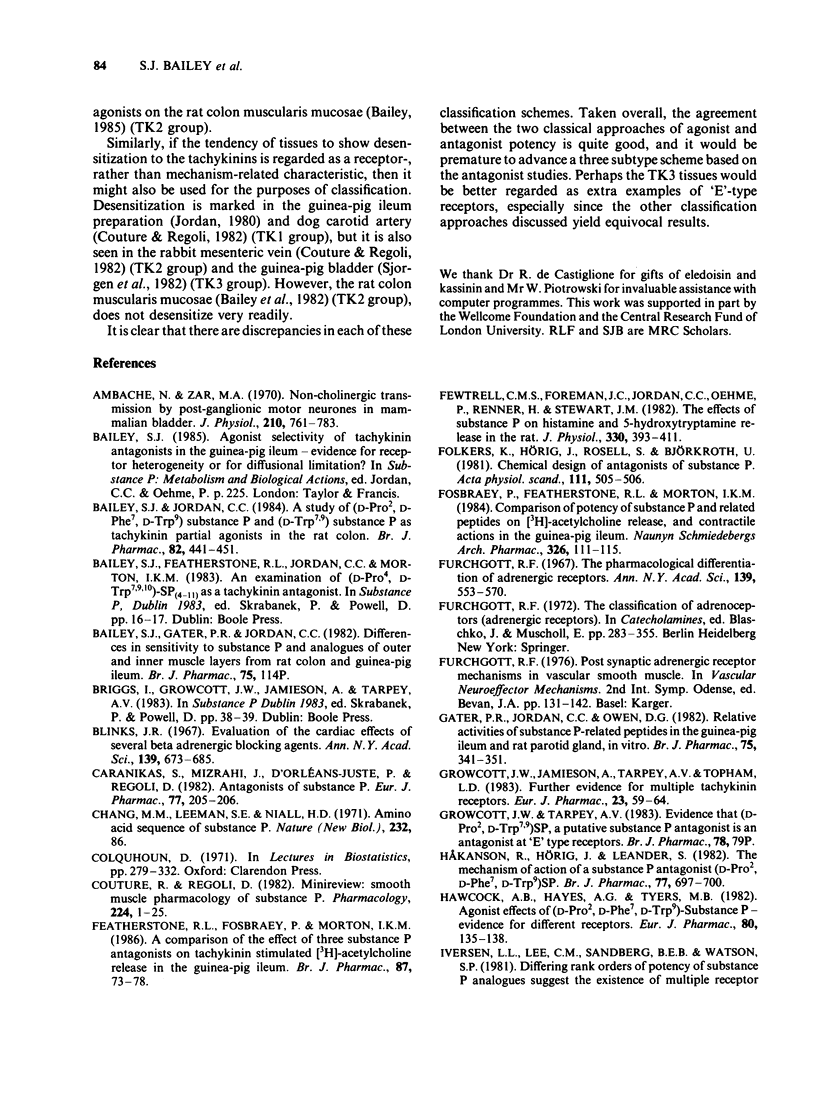
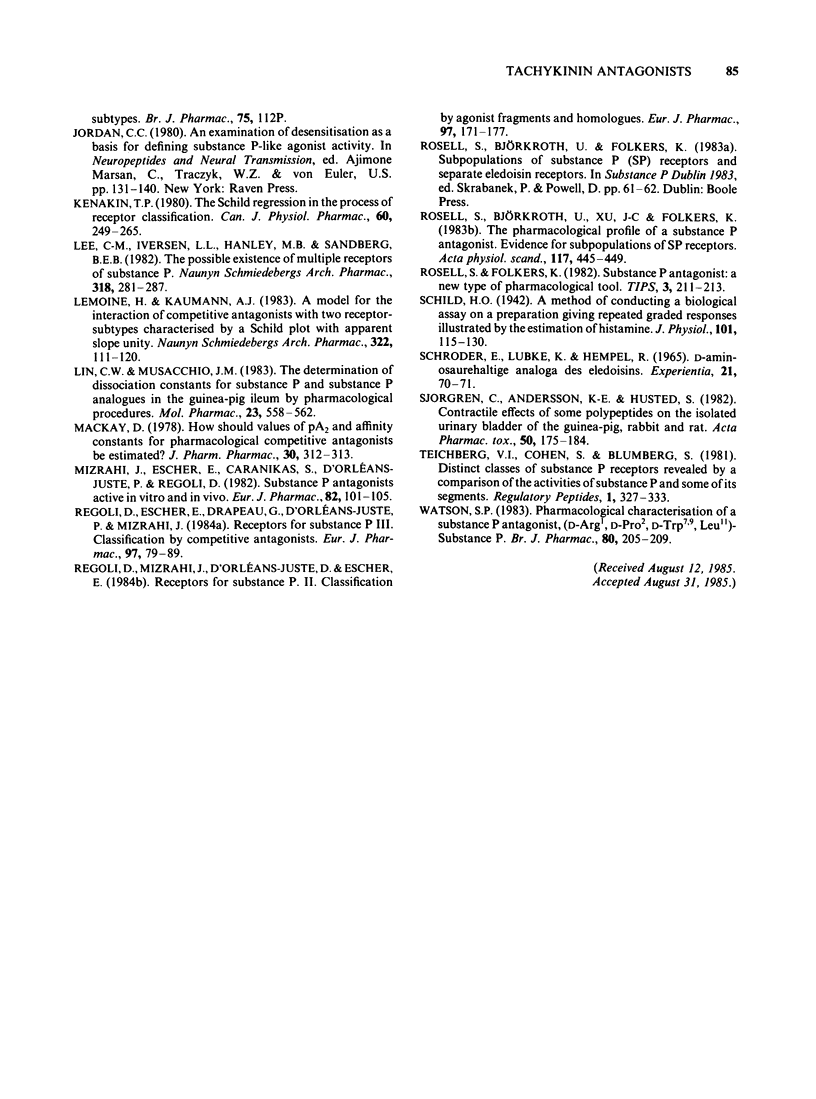
Selected References
These references are in PubMed. This may not be the complete list of references from this article.
- Ambache N., Zar M. A. Non-cholinergic transmission by post-ganglionic motor neurones in the mammalian bladder. J Physiol. 1970 Oct;210(3):761–783. doi: 10.1113/jphysiol.1970.sp009240. [DOI] [PMC free article] [PubMed] [Google Scholar]
- Bailey S. J., Jordan C. C. A study of [D-Pro2, D-Phe7, D-Trp9]-substance P and [D-Trp7,9]-substance P as tachykinin partial agonists in the rat colon. Br J Pharmacol. 1984 Jun;82(2):441–451. doi: 10.1111/j.1476-5381.1984.tb10779.x. [DOI] [PMC free article] [PubMed] [Google Scholar]
- Blinks J. R. Evaluation of the cardiac effects of several beta adrenergic blocking agents. Ann N Y Acad Sci. 1967 Feb 10;139(3):673–685. doi: 10.1111/j.1749-6632.1967.tb41237.x. [DOI] [PubMed] [Google Scholar]
- Caranikas S., Mizrahi J., D'Orléans-Juste P., Regoli D. Antagonists of substance P. Eur J Pharmacol. 1982 Jan 22;77(2-3):205–206. doi: 10.1016/0014-2999(82)90023-1. [DOI] [PubMed] [Google Scholar]
- Couture R., Regoli D. Mini review: smooth muscle pharmacology of substance P. Pharmacology. 1982;24(1):1–25. doi: 10.1159/000137572. [DOI] [PubMed] [Google Scholar]
- Featherstone R. L., Fosbraey P., Morton I. K. A comparison of the effects of three substance P antagonists on tachykinin-stimulated [3H]-acetylcholine release in the guinea-pig ileum. Br J Pharmacol. 1986 Jan;87(1):73–77. doi: 10.1111/j.1476-5381.1986.tb10158.x. [DOI] [PMC free article] [PubMed] [Google Scholar]
- Fewtrell C. M., Foreman J. C., Jordan C. C., Oehme P., Renner H., Stewart J. M. The effects of substance P on histamine and 5-hydroxytryptamine release in the rat. J Physiol. 1982 Sep;330:393–411. doi: 10.1113/jphysiol.1982.sp014347. [DOI] [PMC free article] [PubMed] [Google Scholar]
- Folkers K., Hörig J., Rosell S., Björkroth U. Chemical design of antagonists of substance P. Acta Physiol Scand. 1981 Apr;111(4):505–506. doi: 10.1111/j.1748-1716.1981.tb06771.x. [DOI] [PubMed] [Google Scholar]
- Fosbraey P., Featherstone R. L., Morton I. K. Comparison of potency of substance P and related peptides on [3H]-acetylcholine release, and contractile actions, in the guinea-pig ileum. Naunyn Schmiedebergs Arch Pharmacol. 1984 Jun;326(2):111–115. doi: 10.1007/BF00517306. [DOI] [PubMed] [Google Scholar]
- Furchgott R. F. The pharmacological differentiation of adrenergic receptors. Ann N Y Acad Sci. 1967 Feb 10;139(3):553–570. doi: 10.1111/j.1749-6632.1967.tb41229.x. [DOI] [PubMed] [Google Scholar]
- Gater P. R., Jordan C. C., Owen D. G. Relative activities of substance P-related peptides in the guinea-pig ileum and rat parotid gland, in vitro. Br J Pharmacol. 1982 Feb;75(2):341–351. doi: 10.1111/j.1476-5381.1982.tb08792.x. [DOI] [PMC free article] [PubMed] [Google Scholar]
- Hawcock A. B., Hayes A. G., Tyers M. B. Agonist effects of [D-Pro2,D-Phe7,D-Trp9]substance P--evidence for different receptors. Eur J Pharmacol. 1982 May 7;80(1):135–138. doi: 10.1016/0014-2999(82)90189-3. [DOI] [PubMed] [Google Scholar]
- Håkanson R., Hörig J., Leander S. The mechanism of action of a substance P antagonist (D-Pro2, D-Trp7,9)-SP. Br J Pharmacol. 1982 Dec;77(4):697–700. doi: 10.1111/j.1476-5381.1982.tb09348.x. [DOI] [PMC free article] [PubMed] [Google Scholar]
- Kenakin T. P. The Schild regression in the process of receptor classification. Can J Physiol Pharmacol. 1982 Mar;60(3):249–265. doi: 10.1139/y82-036. [DOI] [PubMed] [Google Scholar]
- Lee C. M., Iversen L. L., Hanley M. R., Sandberg B. E. The possible existence of multiple receptors for substance P. Naunyn Schmiedebergs Arch Pharmacol. 1982 Mar;318(4):281–287. doi: 10.1007/BF00501166. [DOI] [PubMed] [Google Scholar]
- Lemoine H., Kaumann A. J. A model for the interaction of competitive antagonists with two receptor-subtypes characterized by a Schild-plot with apparent slope unity. Agonist-dependent enantiomeric affinity ratios for bupranolol in tracheae but not in right atria of guinea pigs. Naunyn Schmiedebergs Arch Pharmacol. 1983 Mar;322(2):111–120. doi: 10.1007/BF00512383. [DOI] [PubMed] [Google Scholar]
- Lin C. W., Musacchio J. M. The determination of dissociation constants for substance P and substance P analogues in the guinea pig ileum by pharmacological procedures. Mol Pharmacol. 1983 May;23(3):558–562. [PubMed] [Google Scholar]
- MacKay D. How should values of pA2 and affinity constants for pharmacological competitive antagonists be estimated? J Pharm Pharmacol. 1978 May;30(5):312–313. doi: 10.1111/j.2042-7158.1978.tb13237.x. [DOI] [PubMed] [Google Scholar]
- Mizrahi J., Escher E., Caranikas S., D'orléans-Juste P., Regoli D. Substance P antagonists active in vitro and in vivo. Eur J Pharmacol. 1982 Aug 13;82(1-2):101–105. doi: 10.1016/0014-2999(82)90561-1. [DOI] [PubMed] [Google Scholar]
- Regoli D., Mizrahi J., D'Orléans-Juste P., Escher E. Receptors for substance P. II. Classification by agonist fragments and homologues. Eur J Pharmacol. 1984 Jan 27;97(3-4):171–177. doi: 10.1016/0014-2999(84)90448-5. [DOI] [PubMed] [Google Scholar]
- Rosell S., Björkroth U., Xu J. C., Folkers K. The pharmacological profile of a substance P (SP) antagonist. Evidence for the existence of subpopulations of SP receptors. Acta Physiol Scand. 1983 Mar;117(3):445–449. doi: 10.1111/j.1748-1716.1983.tb00019.x. [DOI] [PubMed] [Google Scholar]
- SCHROEDER E., LUEBKE K., HEMPEL R. D-AMINOSAEUREHALTIGE ANALOGA DES ELEDOISINS. Experientia. 1965 Feb 15;21:70–71. doi: 10.1007/BF02144745. [DOI] [PubMed] [Google Scholar]
- Schild H. O. A method of conducting a biological assay on a preparation giving repeated graded responses illustrated by the estimation of histamine. J Physiol. 1942 Jun 2;101(1):115–130. doi: 10.1113/jphysiol.1942.sp003970. [DOI] [PMC free article] [PubMed] [Google Scholar]
- Scholfield C. N. Baclofen blocks postsynaptic inhibition but not the effect of muscimol in the olfactory cortex. Br J Pharmacol. 1983 Jan;78(1):79–84. doi: 10.1111/j.1476-5381.1983.tb09365.x. [DOI] [PMC free article] [PubMed] [Google Scholar]
- Sjögren C., Andersson K. E., Husted S. Contractile effects of some polypeptides on the isolated urinary bladder of guinea-pig, rabbit, and rat. Acta Pharmacol Toxicol (Copenh) 1982 Mar;50(3):175–184. doi: 10.1111/j.1600-0773.1982.tb00960.x. [DOI] [PubMed] [Google Scholar]
- Teichberg V. I., Cohen S., Blumberg S. Distinct classes of substance P receptors revealed by a comparison of the activities of substance P and some of its segments. Regul Pept. 1981 Feb;1(5):327–333. doi: 10.1016/0167-0115(81)90056-2. [DOI] [PubMed] [Google Scholar]
- Watson S. P. Pharmacological characterization of a substance P antagonist, [D-Arg1,D-Pro2,D-Trp7,9,Leu11]-substance P. Br J Pharmacol. 1983 Sep;80(1):205–209. doi: 10.1111/j.1476-5381.1983.tb11067.x. [DOI] [PMC free article] [PubMed] [Google Scholar]


